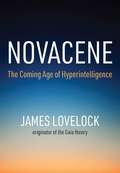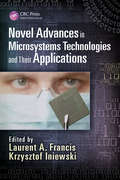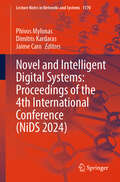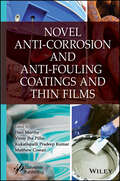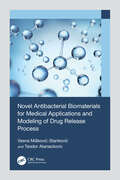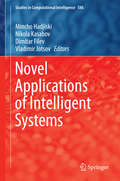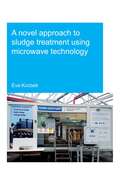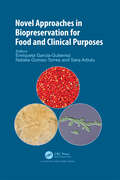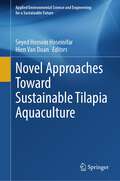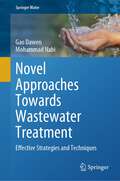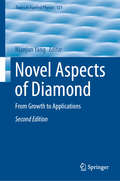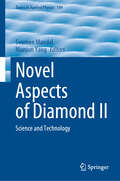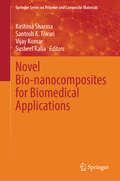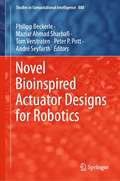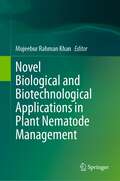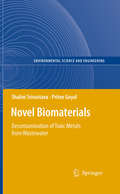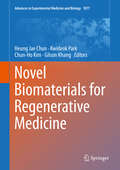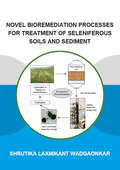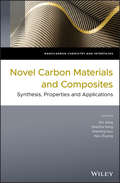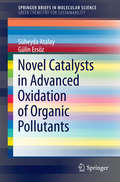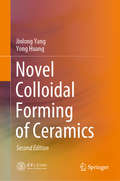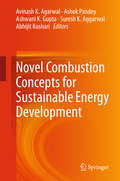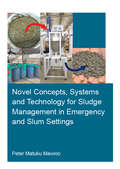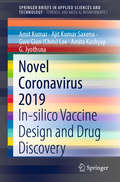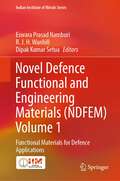- Table View
- List View
Novacene: The Coming Age of Hyperintelligence
by James Lovelock Bryan AppleyardJames Lovelock, creator of the Gaia hypothesis and the greatest environmental thinker of our time, has produced an astounding new theory about the future of life on Earth. He argues that the Anthropocene--the age in which humans acquired planetary-scale technologies--is, after 300 years, coming to an end. A new age--the Novacene--has already begun. In the Novacene, new beings will emerge from existing artificial intelligence systems. They will think 10,000 times faster than we do and they will regard us as we now regard plants. But this will not be the cruel, violent machine takeover of the planet imagined by science fiction. These hyperintelligent beings will be as dependent on the health of the planet as we are. They will need the planetary cooling system of Gaia to defend them from the increasing heat of the sun as much as we do. And Gaia depends on organic life. We will be partners in this project. It is crucial, Lovelock argues, that the intelligence of Earth survives and prospers. He does not think there are intelligent aliens, so we are the only beings capable of understanding the cosmos. Perhaps, he speculates, the Novacene could even be the beginning of a process that will finally lead to intelligence suffusing the entire cosmos. At the age of 100, James Lovelock has produced the most important and compelling work of his life. James Lovelock is the originator of the Gaia hypothesis (now Gaia theory). His many books on the subject include Gaia: A New Look at Life on Earth, The Revenge of Gaia, The Vanishing Face of Gaia, and A Rough Ride to the Future. The author of more than 200 scientific papers, he was elected a Fellow of the Royal Society in 1974."
Novel Advances in Microsystems Technologies and Their Applications (Devices, Circuits, and Systems #16)
by Laurent A. Francis Krzysztof IniewskiMicrosystems technologies have found their way into an impressive variety of applications, from mobile phones, computers, and displays to smart grids, electric cars, and space shuttles. This multidisciplinary field of research extends the current capabilities of standard integrated circuits in terms of materials and designs and complements them by creating innovative components and smaller systems that require lower power consumption and display better performance. Novel Advances in Microsystems Technologies and their Applications delves into the state of the art and the applications of microsystems and microelectronics-related technologies. Featuring contributions by academic and industrial researchers from around the world, this book: Examines organic and flexible electronics, from polymer solar cell to flexible interconnects for the co-integration of micro-electromechanical systems (MEMS) with complementary metal oxide semiconductors (CMOS) Discusses imaging and display technologies, including MEMS technology in reflective displays, the fabrication of thin-film transistors on glass substrates, and new techniques to display and quickly transmit high-quality images Explores sensor technologies for sensing electrical currents and temperature, monitoring structural health and critical industrial processes, and more Covers biomedical microsystems, including biosensors, point-of-care devices, neural stimulation and recording, and ultra-low-power biomedical systems Written for researchers, engineers, and graduate students in electrical and biomedical engineering, this book reviews groundbreaking technology, trends, and applications in microelectronics. Its coverage of the latest research serves as a source of inspiration for anyone interested in further developing microsystems technologies and creating new applications.
Novel and Intelligent Digital Systems: Proceedings of the 4th International Conference (Lecture Notes in Networks and Systems #1170)
by Phivos Mylonas Dimitris Kardaras Jaime CaroThis book compiles the research findings presented at the 4th International Conference on Novel & Intelligent Digital Systems (NiDS 2024), which took place in Athens, Greece, on September 25-27, 2024, hosted by the University of West Attica. NiDS 2024 was conducted in a hybrid format, offering participants the flexibility to join either online or in person. The conference highlighted the latest innovations in intelligent systems and emphasized the collaborative research that advances Artificial Intelligence (AI) in software development. It served as a platform for high-quality research, providing a space to explore challenges and innovations in AI. NiDS 2024 refered to experts, researchers, and scholars in artificial and computational intelligence, as well as the broader field of computer science, offering insights into interconnected and complementary areas. By promoting the exchange of ideas, the conference aimed to strengthen and expand the network of researchers, academics, and industry professionals.
Novel Anti-Corrosion and Anti-Fouling Coatings and Thin Films
by Kukatlapalli Pradeep Kumar Vinay Jha Pillai Hari Murthy Matthew CowanNanomaterials and nanocomposite materials have been developed as corrosion inhibitors and are the most noble and effective alternatives to traditional organic corrosion inhibitors. Nanomaterials provide reasonably high anticorrosive activity in both aqueous and solution phases. A unified approach to this task is lacking, however, which highlights the role of all disciplines involved in the creation and use of corrosion protection coatings for metals. Fouling is the process of accumulating unwanted material that is mostly non-living and comprised of detritus and organic or inorganic compounds, or organisms, such as tiny viruses up to giant kelps. This book covers both the processes of biofouling and anti(bio)fouling, and the devices that stop the biofouling process. This book provides a missing synopsis by providing an understanding of the anticorrosive and anti-biofouling effects of nanomaterials and nanocomposites under different environments. It features an up-to-date picture of the quality and chemistry of a substrate surface, its proper preparation by conversion treatment, the function of resins and anticorrosive pigments in paints, and novel concepts for corrosion protection.
Novel Antibacterial Biomaterials for Medical Applications and Modeling of Drug Release Process
by Vesna Mišković-Stanković Teodor AtanackovicThis book provides a comprehensive review of synthesis and physicochemical and biological characterization of novel antibacterial biomaterials produced according to original procedures and aimed at medical applications such as wound dressing, soft and hard tissue implants, drug delivery devices, and carriers for cell cultivation. It is intended for all researchers working in the fields of biomaterials and biomedical engineering, as well as medical professionals, science and engineering graduate students, academics, and industrial researchers. Includes in-depth discussions on synthesis and physicochemical characterization of novel poly vinyl alcohol-based hydrogels aimed at wound dressings and soft tissue implants Explores synthesis and physicochemical characterization of novel bioceramic hydroxyapatite-based coatings on metal surface aimed for hard tissue implants Reviews cytotoxicity and antibacterial activity of novel poly vinyl alcohol-based hydrogels aimed for wound dressing and soft tissue implants Discusses cytotoxicity and antibacterial activity of bioceramic hydroxyapatite-based coatings on metal surface aimed for hard tissue implants Provides original fractional derivative models of drug release process from hydrogels and bioceramic coatings on metal surface and explores diffusion mechanism
Novel Applications of Intelligent Systems
by Mincho Hadjiski Nikola Kasabov Dimitar Filev Vladimir JotsovIn this carefully edited book some selected results of theoretical and applied research in the field of broadly perceived intelligent systems are presented. The problems vary from industrial to web and problem independent applications. All this is united under the slogan: "Intelligent systems conquer the world". The book brings together innovation projects with analytical research, invention, retrieval and processing of knowledge and logical applications in technology. This book is aiming to a wide circle of readers and particularly to the young generation of IT/ICT experts who will build the next generations of intelligent systems.
A Novel Approach to Sludge Treatment Using Microwave Technology (IHE Delft PhD Thesis Series)
by Eva KocbekSludge transportation costs can represent a large fraction of the expenses associated with municipal and faecal sludge management. These costs can be mitigated through the use of thermal drying approaches to reduce the sludge volume. This thesis described the application of a novel microwave-based pilot-scale unit as an alternative technology for the sanitisation and drying of sludge from municipal wastewater treatment plants and on-site sanitation facilities. The potential economic benefits of volumetric heating, moisture levelling, and increased liquid and vapour migration from the interior to the surface of the product underpins the increasing interest in the use of microwave technology during sludge treatment processes. According to the findings of this study, these factors lead to faster processing times, improved drying rates, and a reduced physical footprint. Furthermore, microwave technology operates as a standalone treatment unit. When coupled with mechanical dewatering techniques and membrane separation technology, it can increase the reliability of the technology employed in the treatment of sludge while recovering valuable resources through an agricultural or thermochemical application such as (co-) combustion. The results of this work demonstrate the strong feasibility of applying microwave-based technology within initiatives designed to protect the environment and safeguard public health.
Novel Approaches in Biopreservation for Food and Clinical Purposes
by Enriqueta Garcia-Gutierrez Natalia Gomez-Torres Sara ArbuluThe aim of "Novel Approaches in Biopreservation for Food and Clinical Purposes" is to provide cutting-edge information on biopreservation methods for both food and medical applications. The book has one chapter dedicated to each major food category (milk and dairy, vegetables, meat, fish, bread, flours and beverages) and brief chapters covering preservation approaches for pharmaceuticals, embryos, gametes, cells and tissues. This book assumes a basic understanding of microbiology and food science, aiming to offer an overview of the most commonly and updated techniques currently used, including protective cultures and fermentation starters, bacterial metabolites, essential oils, bacteriophages or endolysins. By presenting this comprehensive overview, the book aims to advance knowledge in the field of biopreservation and foster its implementation in both food and clinical contexts.
Novel Approaches Toward Sustainable Tilapia Aquaculture (Applied Environmental Science and Engineering for a Sustainable Future)
by Seyed Hossein Hoseinifar Hien Van DoanThe global human population will reach nine billion by 2050, and seafood is projected to be the primary food source to sustain such a large population. According to a recent World Bank report, aquaculture will be the prime source of seafood by 2030. Tilapia is one of the promising species for commercial aquaculture and one of the second most farmed fish worldwide. Given the issues raised by Antibiotic misuse in intensive aquaculture, such as the occurrence of resistant bacteria, it is necessary to develop environment-friendly strategies that could be used to improve production in a sustainable manner. Also, there is a need to establish the best aquaculture practice (BAP) approaches to avoid significant disruption to the ecosystem, the loss of biodiversity, and substantial pollution impact on the environment.The book covers the recent findings regarding sustainable tilapia farming through environment-friendly approaches. This book contains chapters that cover the current status of world tilapia farming and the concept of sustainability of tilapia culture (Chap. 1). Chap. 2 discusses the health management of tilapia with a particular focus on various diseases and treatments. Chap. 3 provides an updated view of the possible effects of feed additives on tilapia reproductive performance. Chap. 4, 5, and 6 cover the recent findings on the gut microbiota of tilapia with a particular focus on structure and modulation. Chap. 7 focuses on the use of medicinal plants for sustainable tilapia farming. Chap. 8 provides insights into the application of alternative protein sources to decrease fish meal consumption. Chap. 9 highlights the importance of culture systems for the development of sustainable tilapia aquaculture. We believe the current book will be very helpful to academics, researchers, and policy-makers in aquaculture.
Novel Approaches Towards Wastewater Treatment: Effective Strategies and Techniques (Springer Water)
by Gao Dawen Mohammad NabiThis book provides an overview of new concept in sustainable technologies for wastewater treatment processes, such as annamox process, granular sludge process, membrane technology, wetlands, and sewage sludge management. With the advancement of water ecological protection and water control standard, it is the general trend to upgrade the wastewater treatment technologies. The simultaneous removal of pollutants is the key to improve the water quality and prevent its further consequences in the downstream. Therefore, it is important to explain/elaborate the new concept of technologies for wastewater treatment. Due to enormous research in the field of wastewater for pollutants removal (particularly COD and N), it is necessary to provide overview in the form of book. The content of this book is of great importance due to their suitability approach covering both environmental protection and market demands (discharge standard). The discovery of anammox process has providedlow-cost and eco-friendly means for treatment of ammonia-rich wastewater with high efficiency, and in this field we (our research group) are pioneer. Therefore, we are interested and confident to write this chapter in our book. The development of aerobic and anaerobic granular sludge process is a better replacement for activated sludge and promises sustainable wastewater treatment for at least the next century. The granular sludge process can simultaneously remove organic carbon, nitrogen, phosphorus, and other pollutants from wastewater, which will be briefly discussed in this book. Wetlands as biological and microbiological approach for wastewater treatment, existing in natural or artificial wetlands and efficiently removing COD and BOD, will be explained in term of design and operation and configurations. Sewage sludge, a residue or by-product of wastewater treatment system, has considerably increased the production over the years. Sludge poses significant risk to both environmentand human health due to its content, pathogens, metal microplastic, and organic matters, if not treated properly. Therefore, its documentation in the form of book is necessary, covering pretreatment implementation, biological treatment, pathogen distribution, and directives around the world. The book primarily not only benefits students, but owing to the great importance of the new concept in wastewater treatment, it is also a valuable work for consulting engineers and other professionals who deal with wastewater treatment.
Novel Aspects of Diamond: From Growth to Applications (Topics in Applied Physics #121)
by Nianjun YangThis book is in honor of the contribution of Professor Xin Jiang (Institute of Materials Engineering, University of Siegen, Germany) to diamond. The objective of this book is to familiarize readers with the scientific and engineering aspects of CVD diamond films and to provide experienced researchers, scientists, and engineers in academia and industry with the latest developments and achievements in this rapidly growing field. This 2nd edition consists of 14 chapters, providing an updated, systematic review of diamond research, ranging from its growth, and properties up to applications. The growth of single-crystalline and doped diamond films is included. The physical, chemical, and engineering properties of these films and diamond nanoparticles are discussed from theoretical and experimental aspects. The applications of various diamond films and nanoparticles in the fields of chemistry, biology, medicine, physics, and engineering are presented.
Novel Aspects of Diamond II: Science and Technology (Topics in Applied Physics #149)
by Nianjun Yang Soumen MandalThis edited book covers a wide range of novel scientific and engineering aspects of diamond films produced from chemical vapor deposition. It focuses on the most recent developments and achievements in this rapidly growing field from scientists and engineers across the domains of chemistry, biology, medicine, physics, and semiconductor engineering.The latest volume of this consistently well-cited book brings an updated, systematic review of the latest developments in diamond research and application. Featuring contributed chapters from a mix of highly-active international researchers, this new edition presents recent research focusing on topics such as diamond for thermal management in high-power electronics, diamond MOSFETs, water treatment, application of machine learning for nanodiamonds, theoretical aspects of diamond growth, current trends in emerging diamond technologies, and the growth of doped single-crystal diamond. This book is especially appealing to interdisciplinary researchers and industry professionals working on advanced diamond devices and applications, as well as theoretical and computational methods for predicting and designing new diamond materials.
Novel Bio-nanocomposites for Biomedical Applications (Springer Series on Polymer and Composite Materials)
by Kashma Sharma Santosh K. Tiwari Vijay Kumar Susheel KaliaThis book presents a comprehensive overview of bio-nanocomposites, from the fundamentals to emerging biomedical applications. Bio-nanocomposites have established themselves as a promising class of hybrid materials derived from natural and synthetic biodegradable polymers and organic/inorganic fillers. Different compositions can, therefore, lead to different applications based on the desired performance. This book introduces a variety of biopolymer nanocomposites, from their synthesis to their structure and applications. The fundamentals and systematic advancements in synthesizing bio-nanocomposites and their characterizations have been highlighted. In addition, the biocompatible and bridgeable properties of bio-nanocomposites are investigated in terms of functionalization, dispersion, and surface manipulation. This book also provides insights into the most recent research in bio-nanocomposites as applied to biomedical fields, including tissue engineering, wound healing, drug delivery, food packaging, agriculture, sensors, and therapies. Finally, the book proposes future prospects and challenges associated with bio-nanocomposites to achieve the desired performance in targeted biomedical applications. Given its scope, this book interests students, academics, and researchers working on the synthesis, biological applications, and pharmaceutical uses of biopolymers and associated nanocomposites.
Novel Bioinspired Actuator Designs for Robotics (Studies in Computational Intelligence #888)
by Philipp Beckerle Maziar Ahmad Sharbafi Tom Verstraten Peter P. Pott André SeyfarthThis book discusses biologically inspired robotic actuators designed to offer improved robot performance and approaching human-like efficiency and versatility. It assesses biological actuation and control in the human motor system, presents a range of technical actuation approaches, and discusses potential applications in wearable robots, i.e., powered prostheses and exoskeletons.Gathering the findings of internationally respected researchers from various fields, the book provides a uniquely broad perspective on bioinspired actuator designs for robotics. Its scope includes fundamental aspects of biomechanics and neuromechanics, actuator and control design, and their application in (wearable) robotics. The book offers PhD students and advanced graduate students an essential introduction to the field, while providing researchers a cutting-edge research perspective.
Novel Biological and Biotechnological Applications in Plant Nematode Management
by Mujeebur Rahman KhanThe volume focuses on novel and effective biological and biotechnological methods for managing major plant parasitic nematodes in economically important agricultural crops. Nematodes develop a wide variety of interactions with soil microbes and host plants, and cause enormous losses in crop yields equivalent to around USD 173 billion annually. In view of growing concern for pesticide contamination in crops, coupled with ban on several efficacious pesticides, and increasing demand for organic foods, the biological and biotechnological approaches offer a good alternative to chemicals for managing nematode infestations in agricultural crops. The book embodies twenty-two chapters which are arranged in two groups. The first group covers different novel methods of nematode management such as biotechnological, biopesticides, microbial consortia, host resistance, omics technology, transgenics, nano-nematicides, nano-diagnosis, etc. The second groups of chapters describe important nematode problems in major crops such as cereals, vegetables, pulses, spices, wood yielding conifers, etc. Overall, the book collates the latest information on above topics and offers practical solutions to the limitations and challenges in the existing management technologies. This book is of interest and serves up-to-date and elaborated information to agriculture researchers, teachers, scientists, under-graduates, post-graduates, plant nematologists, plant pathologists, plant protectionists, agronomists, horticulturalists, helminthologists, extension workers, and NGOs.
Novel Biomaterials
by Shalini Srivastava Pritee GoyalCurrent research revolves around trends to bring technology into harmony with the natural environment and in order to protect the ecosystem. Bioremediation involves processes which reduce the overall treatment costs by using agricultural residues. Regeneration of the biosorbent further increases the cost effectiveness of the process, thus warranting its future success in solving water quality problems. Special emphasis is paid to chemical modifications resulting in tailored novel biomaterials which improve its sorption efficiency and environmental stability. In this way it can be used commercially as a simple, fast, economical, ecofriendly green technology, for the removal of toxic metals from waste water particularly in rural and remote areas of the country.
Novel Biomaterials for Regenerative Medicine (Advances in Experimental Medicine and Biology #1077)
by Heung Jae Chun Kwideok Park Chun-Ho Kim Gilson KhangThis book explores in depth a wide range of new biomaterials that hold great promise for applications in regenerative medicine. The opening two sections are devoted to biomaterials designed to direct stem cell fate and regulate signaling pathways. Diverse novel functional biomaterials, including injectable nanocomposite hydrogels, electrosprayed nanoparticles, and waterborne polyurethane-based materials, are then discussed. The fourth section focuses on inorganic biomaterials, such as nanobioceramics, hydroxyapatite, and titanium dioxide. Finally, up-to-date information is provided on a wide range of smart natural biomaterials, ranging from silk fibroin-based scaffolds and collagen type I to chitosan, mussel-inspired biomaterials, and natural polymeric scaffolds. This is one of two books to be based on contributions from leading experts that were delivered at the 2018 Asia University Symposium on Biomedical Engineering in Seoul, Korea – the companion book examines in depth the latest enabling technologies for regenerative medicine.
Novel Bioremediation Processes for Treatment of Seleniferous Soils and Sediment (IHE Delft PhD Thesis Series)
by Shrutika Laxmikant WadgaonkarThe aim of this Ph.D. was to develop a technology for the remediation of seleniferous soils/sediments and to explore microbial reduction of selenium oxyanions under different respiration conditions and bioreactor configurations. Seleniferous soil collected from the wheat-grown agricultural land in Punjab (India) was characterized and its soil washing was optimized by varying parameters, where addition of oxidizing agents showed a maximum selenium removal efficiency. Aquatic plants, Lemna minor and Egeria densa were used to study phytoremediation of the selenium-rich soil leachate containing oxidizing agents. Additionally, migration of the soluble selenium fraction from the upper to the lower layers and its subsequent reduction and accumulation in the lower layers of the soil column was observed during soil flushing. Furthermore, the soil leachate containing selenium oxyanions obtained from soil washing was treated in a UASB reactor by varying the organic feed. Ex situ bioremediation of selenium oxyanions was studied under variable conditions. An aerobic bacterium (Delftia lacustris) capable of transforming selenate and selenite to elemental selenium was isolated and characterized. Anaerobic bioreduction of selenate coupled to methane oxidation was investigated in serum bottles and a biotrickling filter using marine sediment as inoculum. Finally, the effect of contamination of other chalcogen oxyanions (tellurium) on selenium bioreduction was studied in a continuous system (UASB reactor).
Novel Carbon Materials and Composites: Synthesis, Properties and Applications (Nanocarbon Chemistry and Interfaces)
by Xin Jiang Zhenhui Kang Xiaoning Guo Hao ZhuangConnects knowledge about synthesis, properties, and applications of novel carbon materials and carbon-based composites This book provides readers with new knowledge on the synthesis, properties, and applications of novel carbon materials and carbon-based composites, including thin films of silicon carbide, carbon nitrite, and their related composites. It examines the direct bottom-up synthesis of the carbon-based composite systems and their potential applications, and discusses the growth mechanism of the composite structures. It features applications that range from mechanical, electronic, chemical, biochemical, medical, and environmental to functional devices. Novel Carbon Materials and Composites: Synthesis, Properties and Applications covers an overview of the synthesis, properties, and applications of novel carbon materials and composites. Especially, it covers everything from chemical vapor deposition of silicon carbide films and their electrochemical applications to applications of various novel carbon materials for the construction of supercapacitors to chemical vapor deposition of diamond/silicon carbide composite films to the covering and fabrication processes of nanodot composites. Looks at the recent progress and achievements in the fields of novel carbon materials and composites, including thin films of silicon carbide, carbon nitrite, and their related composites Discusses the many applications of carbon materials and composites Focuses on the hot topic of the fabrication of carbon-based composite materials and their abilities to extend the potential applications of carbon materials Published as a title in the new Wiley book series Nanocarbon Chemistry and Interfaces. Novel Carbon Materials and Composites: Synthesis, Properties and Applications is an important book for academic researchers and industrial scientists working in the fabrication and application of carbon materials and carbon-based composite materials and related fields.
Novel Catalysts in Advanced Oxidation of Organic Pollutants
by Süheyda Atalay Gülin ErsözThis brief summarizes the role of certain catalysts and associated processes that are involved in the reduction or elimination of hazardous substances from wastewater and the exploitation of renewable raw materials. The authors begin by providing a summary of the most recent developments in catalysts used in the advanced oxidation of organic pollutants in aqueous phase. Advanced Oxidation Processes (AOPS) are described in terms of homogeneous and heterogeneous catalysts. Some emphasis is placed on the role nanocatalysts, perovskite-type catalysts, and green catalysts play in several AOPs such as Fenton Chemistry, photocatalytic oxidation, and the hybrid technologies that combine different processes. Catalyst preparation, characterization, reaction chemistry, and process technology are described. Specific wastewater case studies which illustrate the role of these catalysts in AOPs completes the brief.
Novel Colloidal Forming of Ceramics
by Yong Huang Jinlong YangThis book discusses several new, near-net-shape techniques for fabricating highly reliable, high-performance, complex ceramic parts. In the context of materials design, the creation of high-performance ceramic products of desired shapes has led to the need for new ceramic forming processes. The near-net-shape techniques combine both injection-molding and colloidal-forming processes. Reviewing and summarizing the research and latest advances, the book is divided into 6 parts: (1) the basic theory, development, and application of the colloidal injection molding of ceramics; (2) the tape casting technology; (3) the reliability of the product; (4) the colloidal injection molding of Si3N4 and SiC; (5) low-toxicity systems; and (6) the novel in-situ coagulation casting of ceramic suspensions via controlled release of high-valence counter ions and dispersant removal. It is intended for researchers and graduates in materials science and engineering.
Novel Combustion Concepts for Sustainable Energy Development
by Avinash K Agarwal Ashok Pandey Ashwani K. Gupta Suresh K. Aggarwal Abhijit KushariThis book comprises research studies of novel work on combustion for sustainable energy development. It offers an insight into a few viable novel technologies for improved, efficient and sustainable utilization of combustion-based energy production using both fossil and bio fuels. Special emphasis is placed on micro-scale combustion systems that offer new challenges and opportunities. The book is divided into five sections, with chapters from 3-4 leading experts forming the core of each section. The book should prove useful to a variety of readers, including students, researchers, and professionals.
Novel Concepts, Systems and Technology for Sludge Management in Emergency and Slum Settings (IHE Delft PhD Thesis Series)
by Peter Matuku MawiooManagement of sludge is one of the most pressing issues in sanitation provision. The situation is especially complex when large quantities of fresh sludge containing various contaminants are generated in onsite sanitation systems in urban slums, emergency settlements and wastewater treatment facilities that require proper disposal of the sludge. The application of fast and efficient sludge management methods is important under these conditions. This study focused on the development of an innovative sludge treatment unit that is based on the microwave irradiation technology. The technology provides a rapid and efficient option for sludge treatment in isolated conditions such as slum, emergency, and similar situations. The microwave based technology forms part of the eSOS (emergency sanitation operation system) concept that promotes an integrated sanitation approach in which all components of the entire sanitation chain are planned holistically. Besides, the study addresses the deficiencies associated with the poor choice of emergency sanitation technology options by proposing a methodology that is based on compensatory multi-criteria analysis. This study contributes in providing solutions towards improved sanitation in complex scenarios, especially the management of faecal sludge in emergency and slum conditions.
Novel Coronavirus 2019: In-silico Vaccine Design and Drug Discovery (SpringerBriefs in Applied Sciences and Technology)
by Amit Kumar Ajit Kumar Saxena Gwo Giun Lee Amita Kashyap G. JyothsnaThis book highlights the genomic findings, observations, and analysis of DNA/RNA sequences and protein structure of the dreadful virus of this decade- COVID-19. The Corona group of viruses though known species, the strain that caused the Pandemic of 2019 is a completely new strain, belonging to the same corona family with a novel genetic make-up. This makes it a new pathogen which is causing the current outbreak leaving the global scientific community clueless of any therapeutic breakthrough. NCOV enjoys life threatening pathogenicity with mysterious genetic annotations. This book details and offers insights into its viral genetic arrangement, Virulence factors, probable mutations leading to the evolution of this new strain and more. It contains chapters on Virus evolutionary status and Genetic makeup leading to its pathogenicity which can be a new insight in understanding the nature of this clever microorganism and can pave way to the development of new drugs and Vaccines or a novel diagnostic approach for the early prognosis of the disease. A dedicated chapter on annotation of NCOV-19 virulence genes, translation of the genes to protein product, annotation of the antigenic sites on these proteins is also included. In all, this brief is a complete genomic annotation insight of NCOV-19 using AI, Data analytics and Bioinformatics analysis. In the current situation, this book is an extensive preliminary resource for Medical practitioners, Researchers, Academicians, Scientists, Biochemists, Bioinformaticians and other professionals interested in understanding the genetics of Novel Coronavirus 19, the best possible drug targets, ideal vaccine candidates and novel prognostic and diagnostic biomarkers.
Novel Defence Functional and Engineering Materials: Functional Materials for Defence Applications (Indian Institute of Metals Series)
by Eswara Prasad Namburi R. J. H. Wanhill Dipak Kumar SetuaThis book provides the latest developments in functional and engineering materials for defence applications. It contains a total of 20 book chapters in 2 proposed volumes: Vol. 1. Defence Functional Materials and Vol. 2. Defence Engineering Materials. All the book chapters are authored by leading scientists from the premier institutes, such as DRDO laboratory, DMSRDE, Kanpur, India, and edited by Drs. N Eswara Prasad, RJH Wanhill, and DK Setua. Both the authors and the editors are well known internationally for their seminal works in the Functional and Engineering Materials R&D and S&T. The principal purpose of this two-volume book is to provide the salient features of materials selection, synthesis, development and qualification for many a classical applications encompassing aero, naval and ground-based defence systems. They would surely act as valuable vade mecums for both active researchers, defence experts, post-graduate students, and faculty members who like to work and contributeto defence forces through research in areas such as defence materials, products, prototypes, sub-systems and systems that need cutting edge technologies and the latest and best materials and materials solutions.
